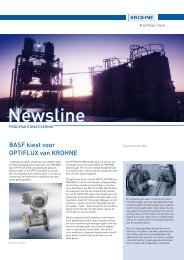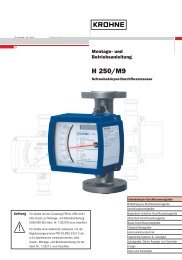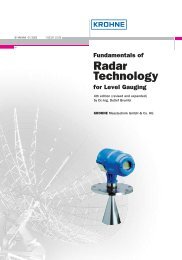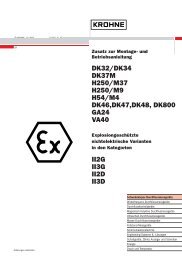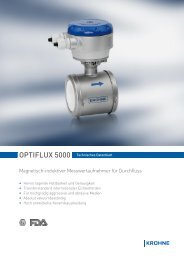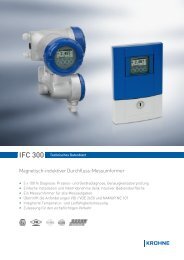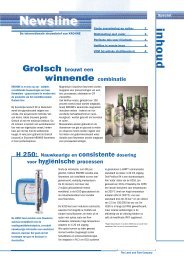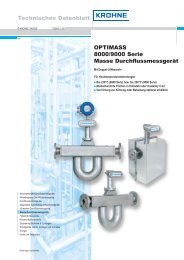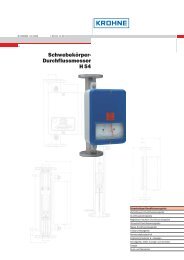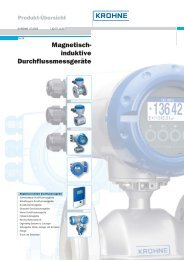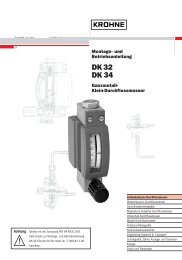Measurement Automation Strategy: Key to Bio-Ethanol ... - Krohne
Measurement Automation Strategy: Key to Bio-Ethanol ... - Krohne
Measurement Automation Strategy: Key to Bio-Ethanol ... - Krohne
Create successful ePaper yourself
Turn your PDF publications into a flip-book with our unique Google optimized e-Paper software.
7 Dearborn Road<br />
Peabody, MA (USA) 01960<br />
800-356-9464/978-535-1720<br />
www.krohne.com<br />
<strong>Measurement</strong> <strong>Au<strong>to</strong>mation</strong> <strong>Strategy</strong>:<br />
<strong>Key</strong> <strong>to</strong> <strong>Bio</strong>-<strong>Ethanol</strong> Refinery Efficiency<br />
By Hemant Narayan, Industry Specialist<br />
February 2008 Copyright KROHNE, Inc.
<strong>Measurement</strong> <strong>Au<strong>to</strong>mation</strong><br />
<strong>Strategy</strong> <strong>Key</strong> <strong>to</strong> <strong>Bio</strong>-<strong>Ethanol</strong><br />
Refinery Efficiency<br />
KROHNE White Paper <strong>Measurement</strong> <strong>Au<strong>to</strong>mation</strong> <strong>Strategy</strong> <strong>Key</strong> <strong>to</strong> <strong>Bio</strong>-<strong>Ethanol</strong> Refinery Efficiency<br />
By Hemant Narayan<br />
Introduction<br />
The conversion of corn in<strong>to</strong> fuel<br />
ethanol is once again gaining<br />
popularity and is an appealing<br />
business opportunity for farm<br />
communities and agribusinesses<br />
in the mid-west and other<br />
regions of the U.S. and Canada.<br />
Inves<strong>to</strong>rs are attracted by the<br />
prospect of more than doubling<br />
the monetary value of a bushel of<br />
corn by converting it in<strong>to</strong> 2.75<br />
gallons of fuel ethanol, 17<br />
pounds of animal feed, and other<br />
value added byproducts.<br />
In the U.S. alone, over 120 plants<br />
are now producing ethanol from<br />
corn feeds<strong>to</strong>ck, and another 76<br />
are under construction. Dozens<br />
more are in various stages of<br />
planning, with <strong>to</strong>tal domestic<br />
production capacity expected <strong>to</strong><br />
double during the next five years.<br />
The Des Moines Register<br />
recently reported that farmers<br />
planted more corn in 2007 than<br />
in any year since 1944, based on<br />
expectations of increased<br />
ethanol production.<br />
The rapid increase in production<br />
reflects the expanding market<br />
for bio-ethanol, driven by<br />
growing recognition of the<br />
economic, social and<br />
environmental benefits of<br />
biofuels. <strong>Ethanol</strong> is increasingly<br />
in demand as an octane-enhancing<br />
substitute for the additive MBTE, which<br />
is being banned in many states. The<br />
2005 Energy Policy Act stimulated the<br />
growth of this industry by offering<br />
federal incentives and goals for<br />
replacing a portion of our nation’s<br />
gasoline requirements with a<br />
renewable fuel source by 2012. Current<br />
estimates indicate we will surpass<br />
these benchmarks well before 2012.<br />
Fourteen billion gallons of ethanol<br />
would be required, if an E10 (10%)<br />
blend were <strong>to</strong> replace all 140 billion<br />
gallons of gasoline consumed in the<br />
U.S. annually. Add <strong>to</strong> this a strong push<br />
from state legislatures for the market<br />
adoption of E85 (85%) blends, and the<br />
growing interest in Canadian and<br />
overseas markets, and it is easy <strong>to</strong><br />
understand the high level of investment<br />
in new production capacity.<br />
Thin Profit Margins<br />
The strong demand, however,<br />
represents only one part of the<br />
profitability equation. The whole<br />
proposition is not profitable if<br />
inefficiencies in the production process<br />
itself add significant costs, as a result<br />
of excess energy consumption, poor<br />
yields, wasteful use of raw materials,<br />
process chemicals and enzymes.<br />
Unfortunately, in many cases, that is<br />
exactly what’s happening.<br />
The cost of natural gas and other<br />
utilities are especially problematic, as<br />
these items far exceed the other major<br />
cost components, including the cost of<br />
plant construction and labor. For<br />
example, in a typical plant, the natural<br />
gas that fuels boilers, evapora<strong>to</strong>rs,<br />
February 20, 2008 2 of 12
KROHNE White Paper <strong>Measurement</strong> <strong>Au<strong>to</strong>mation</strong> <strong>Strategy</strong> <strong>Key</strong> <strong>to</strong> <strong>Bio</strong>-<strong>Ethanol</strong> Refinery Efficiency<br />
By Hemant Narayan<br />
dryers and other equipment<br />
comprises 15% of the cost of<br />
producing a gallon of ethanol.<br />
For a 100MGY plant, that<br />
translates <strong>to</strong> millions of dollars<br />
in operating costs. Conserving<br />
energy by just 1% improves the<br />
bot<strong>to</strong>m line by tens of thousands<br />
of dollars.<br />
The elevated price of natural gas<br />
is not the only financial<br />
challenge. When an ethanol<br />
production facility comes online,<br />
the increased local demand for<br />
corn puts upward price pressure<br />
on corn prices and poses<br />
problems with variability of<br />
feeds<strong>to</strong>ck. Some ethanol<br />
producers report that ethanol<br />
yields vary as much as 7 percent,<br />
depending on the variety of corn.<br />
Lower yields add considerable<br />
financial risk – an anathema <strong>to</strong><br />
inves<strong>to</strong>rs.<br />
Need for Tight Process Control<br />
For these reasons, achieving<br />
consistent profitability can be a<br />
<strong>to</strong>ugh challenge for bio-ethanol<br />
producers. An individual ethanol<br />
producer has little influence on<br />
the market price it receives for<br />
the product it ships and little<br />
control over the price of<br />
feeds<strong>to</strong>ck and natural gas. What<br />
ethanol producers can do – must<br />
do – is tightly control their own<br />
manufacturing process, and<br />
thereby produce consistently<br />
high yield, while minimizing the<br />
consumption of energy and raw<br />
materials, such as yeast,<br />
enzymes, nutrients, and chemicals.<br />
As any business guru will tell you,<br />
process control depends on accurate<br />
and reliable measurement. Process<br />
improvement methodologies, such as<br />
Lean Manufacturing and Six Sigma, are<br />
fundamentally measurement-based<br />
strategies that seek <strong>to</strong> maximize<br />
productivity while eliminating variation.<br />
In fact, measurement is both the second<br />
step and the fifth step of the Six Sigma<br />
DMADV process (define, measure,<br />
analyze, design, verify). However<br />
implementing process control<br />
strategies requires a careful<br />
understanding of process needs,<br />
including identifying measurement<br />
challenges and applying an optimal,<br />
cus<strong>to</strong>mized solution that takes<br />
advantage of the best available<br />
technology.<br />
Importance of Meter Selection and<br />
Placement<br />
Careful selection and installation of<br />
measurement devices is important for<br />
three reasons:<br />
<strong>Measurement</strong> Accuracy.<br />
First and foremost, measurement<br />
devices give visibility <strong>to</strong> the process,<br />
allowing plant opera<strong>to</strong>rs <strong>to</strong> “see” what<br />
is going on inside the pipes and<br />
production systems and how full each<br />
tank is. This is actionable information<br />
that provides the basis for planning and<br />
management systems and for real-time<br />
process control. To be useful, this<br />
information must be accurate.<br />
February 20, 2008 3 of 12
<strong>Au<strong>to</strong>mation</strong>.<br />
KROHNE White Paper <strong>Measurement</strong> <strong>Au<strong>to</strong>mation</strong> <strong>Strategy</strong> <strong>Key</strong> <strong>to</strong> <strong>Bio</strong>-<strong>Ethanol</strong> Refinery Efficiency<br />
By Hemant Narayan<br />
Accurate and reliable<br />
measurement devices enable<br />
au<strong>to</strong>mation by programmable<br />
logic controllers and computer<br />
systems. <strong>Au<strong>to</strong>mation</strong> improves<br />
plant efficiency and production<br />
consistency. <strong>Measurement</strong><br />
devices should have selfdiagnostics<br />
and alarming<br />
capabilities <strong>to</strong> au<strong>to</strong>matically<br />
moni<strong>to</strong>r conditions on a continual<br />
basis and <strong>to</strong> alert opera<strong>to</strong>rs of<br />
problem states such as changes<br />
in flow caused by solids,<br />
entrained gas, or temperature<br />
changes, as well as problems<br />
with the functioning of the<br />
measurement device itself.<br />
Maintenance Costs.<br />
High performance measurement<br />
devices may have a higher initial<br />
purchase cost, but they will<br />
typically have lower <strong>to</strong>tal lifetime<br />
costs, because of the elimination<br />
of downtime for recalibration<br />
and repair. Some manufacturers<br />
now offer interchangeable<br />
components, such as a universal<br />
signal converter that is<br />
compatible with a variety of<br />
meters with different sensor<br />
technologies or different pipe<br />
diameters and flow rates. This<br />
flexibility greatly simplifies<br />
engineering, procurement, and<br />
parts inven<strong>to</strong>ry.<br />
<strong>Measurement</strong> Devices<br />
<strong>Measurement</strong> devices serve several<br />
purposes in an ethanol plant.<br />
Flowmeters<br />
Flowmeters measure the speed and<br />
volume (or, in some cases, the mass) of<br />
liquids and gases that move through a<br />
pipe, including beer, stillage, syrup,<br />
enzymes, water, steam, CO2 and<br />
natural gas, as well as methane used as<br />
an alternate fuel. A wide variety of<br />
flowmetering technology is available,<br />
including Coriolis, magnetic, ultrasonic,<br />
variable area, and vortex-based<br />
devices.<br />
Density meters<br />
Density meters measure the percent<br />
solids during feed s<strong>to</strong>ck preparation.<br />
Density meters also measure the final<br />
alcohol quality (proof) <strong>to</strong> moni<strong>to</strong>r and<br />
control energy intensive processes and<br />
<strong>to</strong> satisfy ASTM documentation<br />
requirements for selling final products<br />
in<strong>to</strong> the transport fuel distribution<br />
system.<br />
Level meter<br />
Level meters indicate the volume of<br />
solids or fluids in a tank, for process<br />
control and inven<strong>to</strong>ry management.<br />
Mechanical devices that utilize<br />
hydrostatic pressure are fast being<br />
replaced by more accurate and reliable<br />
direct level measuring technologies<br />
such as guided wave radars and noncontact<br />
methods that employ radar and<br />
ultrasonic waves.<br />
Other <strong>Measurement</strong>s<br />
At various points in the production<br />
process, it is also necessary <strong>to</strong> measure<br />
February 20, 2008 4 of 12
KROHNE White Paper <strong>Measurement</strong> <strong>Au<strong>to</strong>mation</strong> <strong>Strategy</strong> <strong>Key</strong> <strong>to</strong> <strong>Bio</strong>-<strong>Ethanol</strong> Refinery Efficiency<br />
By Hemant Narayan<br />
and control temperature --<br />
during cooking, fermentation and<br />
distillation, for example – as well<br />
as other attributes such as<br />
pressure, pH, conductivity, and<br />
moisture.<br />
Achieving High Performance<br />
Every stage of production<br />
demands precision, and a plant’s<br />
measuring device supplier must<br />
have a deep understanding of the<br />
entire ethanol production<br />
process, as well as the best<br />
technology available and suitable<br />
for each type of measurement<br />
required.<br />
Performance is not just a<br />
question of selecting the best<br />
technology and device for the<br />
particular application. Proper<br />
placement of the device in the<br />
pipeline or tank is also critically<br />
important <strong>to</strong> ensure not only<br />
accurate measurement but also<br />
<strong>to</strong> avoid dis<strong>to</strong>rtions, clogging and<br />
damage. Achieving good<br />
performance and controlling<br />
<strong>to</strong>tal lifecycle costs also depends<br />
on a preventive maintenance and<br />
periodic calibration checks on<br />
some instruments.<br />
The Production Process<br />
This white paper provides<br />
examples of how accurate<br />
measurement improves<br />
efficiencies and contributes <strong>to</strong><br />
profitability in a typical dry<br />
milling process during the five<br />
main parts of the production<br />
process: conversion,<br />
fermentation, distillation, dehydration,<br />
and recovery of byproducts (e.g., CO2,<br />
and DDGS).<br />
Conversion<br />
Conversion, the first step of the dry<br />
milling process, converts the starch in<br />
the feeds<strong>to</strong>ck <strong>to</strong> simple sugars in<br />
preparation for the subsequent<br />
fermentation process. Such conversion<br />
is not necessary for sugarcane and<br />
other sugar-rich feeds<strong>to</strong>ck sources,<br />
because they do not contain starches<br />
that need <strong>to</strong> be converted in<strong>to</strong><br />
fermentable sugars.<br />
Corn feeds<strong>to</strong>ck is processed using<br />
enzymatic conversion. The feeds<strong>to</strong>ck is<br />
ground in<strong>to</strong> fine particles and mixed<br />
with water <strong>to</strong> prepare corn mash, a<br />
consistent slurry. The grinding process<br />
increases surface area and frees the<br />
starches from inside the protective cell<br />
walls. Alpha amylase enzymes are<br />
typically used for the liquefaction of the<br />
starch-rich grain. A second enzyme,<br />
glucoamylase, is commonly used <strong>to</strong><br />
convert the liquefied starch in<strong>to</strong><br />
glucose (simple sugar) in a process<br />
called saccharification.<br />
Cellulosic feeds<strong>to</strong>ck requires more<br />
complex hydrolysis conversion <strong>to</strong> break<br />
down the closely-bonded cellulose and<br />
hemicellulose from the lignin and<br />
release the fermentable sugars.<br />
Once the feed s<strong>to</strong>ck has been converted<br />
<strong>to</strong> fermentable sugar, the downstream<br />
steps of the dry milling process –<br />
fermentation, distillation and<br />
dehydration – do not tend <strong>to</strong> vary by<br />
type of feeds<strong>to</strong>ck.<br />
February 20, 2008 5 of 12
Fermentation<br />
KROHNE White Paper <strong>Measurement</strong> <strong>Au<strong>to</strong>mation</strong> <strong>Strategy</strong> <strong>Key</strong> <strong>to</strong> <strong>Bio</strong>-<strong>Ethanol</strong> Refinery Efficiency<br />
By Hemant Narayan<br />
Fermentation employs yeast <strong>to</strong><br />
convert the glucose in<strong>to</strong> ethanol.<br />
Fermentation can be done in<br />
batches or continuously when<br />
combined with saccharification.<br />
Depending on yeast strain,<br />
fermentation can take one <strong>to</strong> five<br />
days. Yeast dosage is dependant<br />
on the sugar content and the<br />
desired percent of alcohol at the<br />
end of the fermentation process.<br />
Fermentation severely slows<br />
after reaching 14% alcohol,<br />
because alcohol denatures the<br />
process. However, some types of<br />
yeast can ferment up <strong>to</strong> 21%.<br />
Tightly controlling temperature<br />
is critical <strong>to</strong> maximizing<br />
efficiency, because fermentation<br />
will usually cease above 85°F.<br />
The fermentation process<br />
produces “beer” containing<br />
diluted alcohol and solids. Two<br />
downstream processes,<br />
distillation and dehydration,<br />
extract the liquid and purify it in<br />
steps <strong>to</strong> achieve 100% alcohol<br />
content (200 proof) as required<br />
for E100 fuel ethanol<br />
specification.<br />
Carbon dioxide (CO2)<br />
Carbon dioxide (CO2), a second<br />
co-product of the ethanol<br />
production process, is given off<br />
in large quantities during<br />
fermentation. As a gas, CO2 is<br />
colorless, odorless, and<br />
incombustible. In its liquid form,<br />
CO2 reaches an extreme -17°F,<br />
which makes it an excellent<br />
source for cooling and freezing<br />
applications. CO2 vapors released from<br />
fermentation are usually scrubbed <strong>to</strong><br />
recover any alcohol vapors and cleaned.<br />
If sold <strong>to</strong> commercial users, the CO2 is<br />
liquefied. Otherwise, it is typically<br />
released back in<strong>to</strong> atmosphere.<br />
Distillation<br />
Distillation is the process by which<br />
alcohol is separated from the mash and<br />
water. It exploits the difference in<br />
boiling points between alcohol and<br />
water. Distillation can only purify the<br />
ethanol <strong>to</strong> about 94% alcohol (6%<br />
water), because water and alcohol form<br />
an azeotrope at atmospheric pressure.<br />
Dehydration<br />
Dehydration A molecular sieve is the<br />
simplest method and most common<br />
method of purifying ethanol from 190 <strong>to</strong><br />
200 proof.<br />
Evaporation and Drying<br />
Evaporation and Drying The solids<br />
waste at the bot<strong>to</strong>m of (a?) beer well is<br />
processed separately in a<br />
centrifuge/evaporation/drying process<br />
<strong>to</strong> produce distillers dried grains with<br />
solubles (DDGS). Distillers grains are<br />
rich in cereal proteins, fat, minerals,<br />
and vitamins, and they serve as an<br />
excellent source of digestible protein<br />
and energy.<br />
Each area of the plant described briefly<br />
above – milling, slurry preparation,<br />
liquefaction, fermentation, distillation,<br />
dehydration, evaporation and drying —<br />
requires a measurement solution that<br />
provides an optimal relationship<br />
between performance and purchase<br />
February 20, 2008 6 of 12
KROHNE White Paper <strong>Measurement</strong> <strong>Au<strong>to</strong>mation</strong> <strong>Strategy</strong> <strong>Key</strong> <strong>to</strong> <strong>Bio</strong>-<strong>Ethanol</strong> Refinery Efficiency<br />
By Hemant Narayan<br />
price. This performance includes<br />
not only accuracy, but also<br />
reliability and durability, as well<br />
as frequency and method of<br />
calibration, and lifetime<br />
maintenance costs.<br />
Optimizing Solids <strong>Measurement</strong><br />
Most production opera<strong>to</strong>rs<br />
understand the importance of<br />
percent solids control for an<br />
effective fermentation process,<br />
and measurements are routinely<br />
conducted at various points in<br />
the process. Unfortunately, most<br />
percent solids measurements<br />
are performed only periodically,<br />
by a labora<strong>to</strong>ry moisture<br />
analyzer. Although the lab<br />
analyzer may be calibrated for<br />
high accuracies, this sampling<br />
and testing process usually<br />
proves unreliable in practice,<br />
and is extremely difficult <strong>to</strong> get<br />
repeatable results.<br />
As a result, an increasing<br />
number of plant opera<strong>to</strong>rs are<br />
opting for real-time, online<br />
measurement <strong>to</strong> continuously<br />
moni<strong>to</strong>r the contents of the<br />
mixing tank and make<br />
instantaneous changes <strong>to</strong> the<br />
process. Plants are thereby able<br />
<strong>to</strong> maintain process<br />
requirements within acceptable<br />
<strong>to</strong>lerances (typically within<br />
0.5%). This real time<br />
measurement and control allows<br />
more consistency in the slurry<br />
mix solids and enables opera<strong>to</strong>rs<br />
<strong>to</strong> push the solids percentage<br />
higher, thereby reducing flow<br />
problems and enzyme usage and other<br />
costs. Continuous moni<strong>to</strong>ring of solids<br />
concentration facilitates the detection<br />
and prompt correction of any slow<br />
decrease in solids.<br />
By continually measuring percent<br />
solids, a record is established for each<br />
fermentation batch. The data facilitates<br />
realistic prediction of the outcome of<br />
the fermentation process, in order <strong>to</strong><br />
optimize the overall process by<br />
reducing problems with previous known<br />
flow issues. The solids data can also<br />
be used <strong>to</strong> improve the beer well<br />
averages, a key fac<strong>to</strong>r in increasing<br />
alcohol yields.<br />
The newest generation of industrial<br />
grade Coriolis meters has proven <strong>to</strong><br />
provide highly accurate and repeatable<br />
density measurements, as the basis of<br />
good solids measurement.<br />
Unfortunately, the “bent” design and<br />
internal flow splitters in previous<br />
generations of Coriolis meters<br />
frequently failed due <strong>to</strong> fouling and<br />
blockages. These problems have been<br />
eliminated by the single, straight tube<br />
OPTIMASS 7000 series coriolis meters<br />
developed by KROHNE, Inc. The single,<br />
straight tube design provides an<br />
affordable, accurate and highly reliable<br />
solids measurement solution.<br />
Optimizing <strong>Ethanol</strong> Rectification and<br />
Dehydration<br />
Rectification and dehydration provide a<br />
textbook case of the importance of<br />
accurate measurement for effective<br />
process control.<br />
The rectification and dehydration are<br />
common <strong>to</strong> any fuel ethanol process,<br />
whether wet milling, dry grind or<br />
February 20, 2008 7 of 12
KROHNE White Paper <strong>Measurement</strong> <strong>Au<strong>to</strong>mation</strong> <strong>Strategy</strong> <strong>Key</strong> <strong>to</strong> <strong>Bio</strong>-<strong>Ethanol</strong> Refinery Efficiency<br />
By Hemant Narayan<br />
cellulosic. The goal of the<br />
rectification process is <strong>to</strong> achieve<br />
maximum purification (up <strong>to</strong> 190<br />
proof). Then the dehydration<br />
process employs molecular<br />
sieves <strong>to</strong> convert the 190 proof<br />
ethanol in<strong>to</strong> 200 proof ethanol,<br />
going from 5% moisture content<br />
<strong>to</strong> 0%.<br />
If the process fluid moves <strong>to</strong>o<br />
quickly through the molecular<br />
sieves and some moisture<br />
remains, then the entire batch<br />
must be run back through the<br />
dehydration system again – a<br />
completely inefficient step that<br />
wastes energy and ties up<br />
production capacity and<br />
potentially causes a bottleneck<br />
for the entire plant. To avoid this<br />
problem, a plant could extend<br />
the dwell time in the molecular<br />
sieves <strong>to</strong> ensure that all<br />
moisture is removed. However,<br />
this margin of comfort comes at<br />
a cost in terms of productivity<br />
loss and unnecessary energy<br />
consumption.<br />
Alcohol proof measurement of<br />
rectifier output (190 proof) and<br />
dehydration output (200 proof)<br />
can dramatically improve<br />
process efficiency. Precise<br />
density measurements, detects<br />
exactly when the ethanol reaches<br />
the anhydrous threshold (zero<br />
moisture content), so that the<br />
dehydration process can meet its<br />
target without overreaching,<br />
thereby obviating the need for<br />
any wasteful comfort margin.<br />
As with the percent-solids<br />
measurement application discussed<br />
above, the new generation of Coriolis<br />
meters with single, straight tube<br />
design, has proven <strong>to</strong> be a highly<br />
accurate and reliable solution for realtime<br />
moni<strong>to</strong>ring of alcohol proof during<br />
the rectification and dehydration<br />
processes. The continuous trends data<br />
allows for instantaneous correction of<br />
process upsets and ensures the<br />
consistent and tight control of proof<br />
values in final product. This process<br />
control is critical <strong>to</strong> meeting quality<br />
control specifications and <strong>to</strong> increasing<br />
throughput and profitability.<br />
An important advantage of the state-ofthe-art<br />
Coriolis meters, such as the<br />
KROHNE 7000 Series T80 OPTIMASS<br />
meter, is the ability <strong>to</strong> measure<br />
multiple parameters in a single device –<br />
proof, density, temperature and flow.<br />
Previously, plant opera<strong>to</strong>rs needed <strong>to</strong><br />
purchase, install, calibrate and<br />
maintain several separate devices <strong>to</strong><br />
perform all these functions: typically<br />
one meter would measure density and<br />
proof on a slipstream, and additional<br />
instruments would be installed in the<br />
main line <strong>to</strong> measure temperature and<br />
flow.<br />
More Efficient Dryer Operation<br />
Single straight tube Coriolis meters,<br />
with multiple-parameter capability,<br />
also provide high pay backs when<br />
installed on the evapora<strong>to</strong>r syrup draw.<br />
Installations of an online flow/density<br />
meter at the intermediate and final<br />
stages of the evapora<strong>to</strong>r process have<br />
successfully demonstrated significant<br />
reductions in energy consumption, by<br />
February 20, 2008 8 of 12
KROHNE White Paper <strong>Measurement</strong> <strong>Au<strong>to</strong>mation</strong> <strong>Strategy</strong> <strong>Key</strong> <strong>to</strong> <strong>Bio</strong>-<strong>Ethanol</strong> Refinery Efficiency<br />
By Hemant Narayan<br />
tightly controlling the syrup<br />
percent and flow rate through<br />
the evapora<strong>to</strong>rs.<br />
Running syrups at higher solids<br />
is desirable, because less<br />
moisture means less work for<br />
the dryers and therefore lower<br />
energy consumption in the drying<br />
process. Higher solids<br />
percentage (i.e., lower moisture<br />
content) can be achieved by<br />
reducing the flow rate through<br />
evapora<strong>to</strong>rs which increases<br />
retention time. Unfortunately,<br />
lower flow rates can cause<br />
extensive build up inside the<br />
lines and can also affect the<br />
evapora<strong>to</strong>r efficiency, and line<br />
plugging can cause costly<br />
downtime. For these reasons,<br />
plant opera<strong>to</strong>rs need <strong>to</strong> manage<br />
the process <strong>to</strong> maintain the<br />
optimal solids level at all times.<br />
As with other processes, the<br />
continual, au<strong>to</strong>mated<br />
measurement by coriolis meters<br />
facilitates better control than<br />
offline lab samples. The single,<br />
straight tube design of the<br />
KROHNE Coriolis meters<br />
mitigates the maintenance and<br />
reliability problems that can<br />
plague conventional "bent tube"<br />
Coriolis meters, especially given<br />
the high solids content and<br />
viscosity of the syrup. The<br />
KROHNE Coriolis meters employ<br />
adaptive sensing technologies<br />
(AST), a patented design makes<br />
accurate measurements even of<br />
mixtures with high viscosity or<br />
solid matter content and the<br />
straight-tube design causes less<br />
pressure drops than other flowmeters,<br />
resulting in lower energy costs.<br />
Volumetric Flow metering<br />
Upstream of fermentation, dry-milling<br />
ethanol plants make extensive use of<br />
inline electromagnetic flowmeters <strong>to</strong><br />
measure flows containing high solids<br />
content, such as backset, corn slurry,<br />
mash, beer, as well as on whole, thick<br />
and thin stillage. Most magnetic<br />
flowmeters available in the market<br />
<strong>to</strong>day use a pulsed DC technology which<br />
has replaced older AC technology that<br />
had inherent problems with drift and<br />
zero stability. However, pulsed DC<br />
magnetic flowmeters have performance<br />
limitations, especially with noisy<br />
applications such as slurry.<br />
These problems can be addressed by<br />
using the KROHNE IFC3000 signal<br />
converters with digital noise filtering<br />
and a low-noise electrode<br />
configuration. For demanding, highsolids<br />
applications, KROHNE’s<br />
advanced magnetic flowmeters provide<br />
self-diagnostic capabilities for<br />
detecting sensor coating degradation<br />
and predicting electrode or liner<br />
failure, in order <strong>to</strong> minimize failures<br />
and expensive downtimes.<br />
The multiple-parameter capability of<br />
some magnetic flowmeters, such as the<br />
KROHNE OPTIFLUX 4300C, provides an<br />
added benefit during CIP procedures.<br />
The CIP wash includes flushing the<br />
lines and recirculation chemical in a<br />
specific sequence, such as acid-wateralkali-water.<br />
By using the conductivity<br />
measurement feature built in<strong>to</strong> the<br />
flowmeter, the process can be<br />
February 20, 2008 9 of 12
KROHNE White Paper <strong>Measurement</strong> <strong>Au<strong>to</strong>mation</strong> <strong>Strategy</strong> <strong>Key</strong> <strong>to</strong> <strong>Bio</strong>-<strong>Ethanol</strong> Refinery Efficiency<br />
By Hemant Narayan<br />
controlled au<strong>to</strong>matically and<br />
remotely <strong>to</strong> ensure a more<br />
efficient CIP cycle, facilitating<br />
chemical reuse and reducing<br />
waste.<br />
Applications downstream of the<br />
rectification process pose a<br />
challenge for magnetic<br />
flowmeters due <strong>to</strong> very low<br />
conductivities. In such cases,<br />
alternative technologies,<br />
including vortex shedding and<br />
ultrasonic, provide a better<br />
solution. Flowmeters with<br />
moving parts, such as turbines<br />
and paddle wheel, are prone <strong>to</strong><br />
coating and mechanical failure.<br />
The KROHNE UFM3030 inline<br />
triple beam ultrasonic flow<br />
meters have demonstrated<br />
better value over competing<br />
vortex shedding technologies<br />
due <strong>to</strong> high accuracy and<br />
repeatability over a wider<br />
turndown.<br />
Controlling Steam Consumption<br />
Flowmeters also play a critical<br />
role in controlling energy<br />
consumption by measuring the<br />
flow of steam used extensively in<br />
cooking, dehydration and<br />
evaporation. Steam<br />
measurements are performed on<br />
a mass flow basis, even though<br />
the high moisture contents in<br />
saturated steam vapors causes<br />
failure of true mass flow sensing<br />
designs such as Coriolis and<br />
thermal mass meters.<br />
Consequently, volumetric<br />
devices such as orifice plates or<br />
vortex meters are extensively<br />
used. Unfortunately, most of these<br />
volumetric devices measure the velocity<br />
of steam in the pipeline and compute<br />
volumetric flow rate from the line size.<br />
When outputting mass flow, they use a<br />
fixed density correction <strong>to</strong> convert<br />
volumetric flow <strong>to</strong> mass flow, usually<br />
calculated around a fixed operating<br />
pressure. This fixed correction will<br />
cause significant errors in the final<br />
mass flow during inevitable changes of<br />
the operating pressure (density) of the<br />
steam. Field tests show that a 10%<br />
change in saturated steam line<br />
pressure can cause a fixed-density<br />
compensated meter <strong>to</strong> over/under read<br />
by up <strong>to</strong> 25%, even though the primary<br />
volumetric measurement from meter is<br />
well below 1%.<br />
The KROHNE OPTISWIRL 4070<br />
multivariable steam meter was<br />
designed specifically <strong>to</strong> overcome these<br />
challenges. It precisely measures flow<br />
rate, pressure and temperature with<br />
integrated sensors and provides<br />
accurate density compensation for<br />
highly accurate mass flow<br />
measurement independent of operating<br />
conditions. The fully-welded stainless<br />
steel construction makes the<br />
measuring tube of the OPTISWIRL<br />
highly resistant <strong>to</strong> pressure,<br />
temperature, corrosion and aging and<br />
provides high immunity <strong>to</strong> water<br />
hammer even of wet steam<br />
applications.<br />
Accurate steam metering is critical not<br />
only for controlling the flow of steam<br />
and regulating temperature, but it also<br />
provides a dependable means for<br />
determining loss and wastage.<br />
February 20, 2008 10 of 12
Improved Inven<strong>to</strong>ry Management<br />
KROHNE White Paper <strong>Measurement</strong> <strong>Au<strong>to</strong>mation</strong> <strong>Strategy</strong> <strong>Key</strong> <strong>to</strong> <strong>Bio</strong>-<strong>Ethanol</strong> Refinery Efficiency<br />
By Hemant Narayan<br />
Level meters play an important<br />
role in improving the plant’s<br />
bot<strong>to</strong>m line by enabling tighter<br />
inven<strong>to</strong>ry management and<br />
process control. For example,<br />
accurate measurement allows<br />
close tracking of the use of the<br />
enzymes in the slurry tanks<br />
during the mash preparation<br />
process, and of the chemical<br />
consumption in the clean-inplace<br />
routines. <strong>Measurement</strong> of<br />
the level in fermentation tanks<br />
enables the regulation of foam,<br />
which can be a challenge when<br />
controlling a fermentation<br />
process. Level measurement is<br />
also critical <strong>to</strong> operating<br />
reboilers and distillation tanks,<br />
as well as final s<strong>to</strong>rage tanks.<br />
Simply put, you need <strong>to</strong> know<br />
exactly how much material you<br />
have, and how much you are<br />
using.<br />
Reboilers, Distillation Tanks<br />
and Final S<strong>to</strong>rage<br />
For reboilers, distillation tanks<br />
and final s<strong>to</strong>rage<br />
tank farms, the KROHNE BM26A<br />
side mount level<br />
gauge offers high reliability over<br />
technologies that have problems<br />
measuring under <strong>to</strong>ugh<br />
conditions of vacuum, high<br />
temperatures, vapor phases and<br />
foaming.<br />
Some level measuring systems<br />
deployed use hydrostatic<br />
pressure <strong>to</strong> measure from the<br />
bot<strong>to</strong>m of the tank. This is an<br />
indirect method of measurement that<br />
assumes a constant density <strong>to</strong><br />
determine the actual surface level.<br />
However, when the temperature<br />
changes, the density of the medium will<br />
change, causing a change in pressure,<br />
even though the level of material in the<br />
tank has not changed. Pressurized<br />
tanks need additional compensation.<br />
An alternative approach is <strong>to</strong> use noncontact<br />
radar or guided radar level<br />
devices <strong>to</strong> directly detect the level from<br />
the <strong>to</strong>p of the tank. These methods<br />
measure distance and they are<br />
unaffected by pressure changes, vapors<br />
or tank pressure. Top-of-tank<br />
placement also makes repair or<br />
replacement easier. Bot<strong>to</strong>m-of-tank<br />
implementations can only be serviced<br />
when the tank is empty — a rare<br />
occurrence in active, high-volume<br />
plants.<br />
Return on Investment<br />
<strong>Ethanol</strong> production holds great promise<br />
for our country’s energy future and also<br />
provides an excellent opportunity <strong>to</strong><br />
support our domestic agricultural<br />
economy and communities.<br />
Investments in plant infrastructure<br />
<strong>to</strong>day will yield benefits for years <strong>to</strong><br />
come.<br />
As more and more plants come online,<br />
competition naturally increases among<br />
producers. As the market matures, it<br />
will demand the highest possible<br />
quality at the lowest price. In this<br />
economical environment, producers<br />
will maintain profitability only by<br />
controlling production costs, reducing<br />
waste, and conserving energy wherever<br />
possible.<br />
February 20, 2008 11 of 12
KROHNE White Paper <strong>Measurement</strong> <strong>Au<strong>to</strong>mation</strong> <strong>Strategy</strong> <strong>Key</strong> <strong>to</strong> <strong>Bio</strong>-<strong>Ethanol</strong> Refinery Efficiency<br />
By Hemant Narayan<br />
Investing in the plant’s<br />
measurement systems both<br />
during new construction or<br />
retrofit, is one area that has been<br />
proven <strong>to</strong> offer high returns in<br />
the form of increased<br />
productivity and lower costs.<br />
February 20, 2008 12 of 12




